Charts
Charting Brett Favre’s 508 Career Touchdown Passes
From 1992 through his retirement in 2010, there were very few Quarterbacks who were better than Brett Favre in the NFL. Over the course of his legendary career, the Pro Football Hall of Fame inductee and Green Bay Packers legend registered 71,838 passing yards and 508 touchdown passes. Not only that, but he was the NFL’s MVP three consecutive years in a row (1995-1997) and was elected to eleven Pro Bowls.
From Billy Anneken, this visual shows who caught touchdown passes from Brett Favre over #4’s career, which spanned 20 seasons in the National Football League.
Click below to zoom
Over the course of his storied NFL career, Brett Favre threw for 508 touchdown passes. Of these 508 scores through the air, a total of 61 players caught them across Favre’s stints with three different teams — the Green Bay Packers, the New York Jets and the Minnesota Vikings. His scores were spread across to six different Jets players, ten different Vikings players, and 45 different Packers players.
The player with the most touchdown receptions from Brett Favre was Antonio Freeman, who found the end zone on 57 occasions. Freeman was originally drafted by the Green Bay Packers in the third round of the 1995 NFL Draft, and would spend time with the Packers from 1995 – 2001. He would later have stints with both the Philadelphia Eagles and the Miami Dolphins. Today, Antonio Freeman is a member of the Green Bay Packers Hall of Fame.
Here are the receivers who caught touchdowns from the legendary Brett Favre, along with how many scores from the Hall of Famer.
- Antonio Freeman: 57 touchdowns
- Sterling Sharpe: 41 touchdowns
- Donald Driver: 36 touchdowns
- Robert Brooks: 32 touchdowns
- Bubba Franks: 29 touchdowns
- Jason Walker: 19 touchdowns
- Bill Schroeder: 19 touchdowns
- Dosey Levens: 16 touchdowns
- Mark Chmura: 16 touchdowns
- Greg Jennings: 14 touchdowns
- Ahman Green: 14 touchdowns
- William Henderson: 13 touchdowns
- Visanthe Schiancoe: 12 touchdowns
- Tyrone Davis: 12 touchdowns
- Robert Ferguson: 12 touchdowns
- Keith Jackson: 11 touchdowns
- Percy Harvin: 11 touchdowns
- Edgar Bennett: 10 touchdowns
- David Martin: 9 touchdowns
- Anthony Morgan: 8 touchdowns
- Donald Lee: 8 touchdowns
- Corey Bradford: 7 touchdowns
- Sidney Rice: 7 touchdowns
- Laveranues Coles: 7 touchdowns
- Jackie Harris: 6 touchdowns
- Jerricho Cotchery: 5 touchdowns
- Tony Fisher: 5 touchdowns
- Derrick Mayes: 5 touchdowns
- Antonio Chatman: 5 touchdowns
- Berrnard Barrian: 4 touchdowns
- Don Beebe: 4 touchdowns
- Ruvell Martin: 4 touchdowns
- Chansi Stuckey: 3 touchdowns
- Mark Clayton: 3 touchdowns
- Terry Mickens: 3 touchdowns
- Mark Ingram: 3 touchdowns
- Dustin Keller: 3 touchdowns
- Terry Glenn: 2 touchdowns
- Leon Washington: 2 touchdowns
- Thomas Jones: 2 touchdowns
- James Jones: 2 touchdowns
- Ed West: 2 touchdowns
- Jeff Thomason: 2 touchdowns
- Randy Moss: 2 touchdowns
- Jeff Dugan: 2 touchdowns
- Noah Herron: 2 touchdowns
- Charles Jordan: 2 touchdowns
- Harry Sydney: 1 touchdown
- Andre Rison: 1 touchdown
- Koren Robinson: 1 touchdown
- Reggie Cobb: 1 touchdown
- Samkon Gado: 1 touchdown
- Adrian Peterson: 1 touchdown
- Kitrick Taylor: 1 touchdown
- Darrell Thompson: 1 touchdown
- Wesley Walls: 1 touchdown
- Greg Camarillo: 1 touchdown
- Greg Lewis: 1 touchdown
- Chester Taylor: 1 touchdown
- Naufahu Tahi: 1 touchdown
- Charles Lee: 1 touchdown
Charts
Study Examines Where Renters Can and Cannot Afford to Buy Their Homes
Home ownership is a dream shared by many Americans, but the goal posts for achieving this dream move further out of reach every year. In 2025, the average age for first-time home ownership reached an all-time high of 40 years old. That’s an 8-year increase from just 5 years previous. The biggest obstacle to home ownership is the high price tag. Housing prices have risen by an astonishing 2,000% over the past 60 years. While these statistics might make home ownership seem impossible, the team at MovingPlace.com shows that location is a huge factor in affordability. The team analyzed which ZIP codes have renters who could afford to buy a home. They mapped the results, showing where home ownership is most achievable and where it is flat-out impossible.
Click below to zoom.
To form their calculations, the team analyzed these factors:
- Median Home Value
- Mortgage Rate
- Monthly Mortgage Payment
- Renter Income
- Monthly Renter Income
- Mortgage-to-Income Ratio
- Average Cost of Rent
- Rent-to-Income Ratio
The results show us that these are the ZIP codes where renters can afford to buy their own home:
- 30349: Atlanta, GA
- 75217: Dallas, TX
- 60617: Chicago, IL
- 37042: Clarkesville, TN
- 60629: Chicago, IL
- 73099: Yukon, OK
- 60623: Chicago, IL
- 78577: Pharr, TX
- 27610: Raleigh, NC
- 28269: Charlotte, NC
The ZIP code with the lowest mortgage-to-income ratio is in Fulton County, Georgia. There are 15 cities in this county, including Atlanta, one of the largest American cities. The result comes as no surprise since Atlanta is one of the most affordable major cities in the country.
On the other end of the spectrum, there are many ZIP codes where homes are so expensive that renters can’t hope to buy in these locations. Here are the ZIP codes with the most prohibitive ratios:
- 11204: Brooklyn, NY
- 10453: Bronx, NY
- 98052: Redmond, WA
- 10025: New York, NY
- 11385: Ridgewood, NY
- 98012: Bothell, WA
- 91709: Chino Hills, CA
- 10314: Staten Island, NY
- 60647: Chicago, IL
- 90250: Hawthorne, CA
Brooklyn has the least affordable American ZIP code. Average renter incomes simply don’t compare with the median home price in Brooklyn, which is $1,198,458. This could pay for five homes in Fulton County, Georgia.
Overall, the team followed a 28/36 ratio rule. The mortgage-to-income ratio had to be below 28% to be considered affordable. We can also see that different areas of a city can differ drastically in home prices. For example, two ZIP codes within the city of Chicago in Cook County are on the most affordable list, while another ZIP code is on the least affordable list. This is nothing new in real estate. Some neighborhoods are more highly sought after than others, and competition drives up prices to shocking heights.
While home ownership is no doubt a challenge, this map shows that there are many places in the U.S. where it’s possible for renters to start house shopping. Location is one of the biggest factors in making the dream of homeownership a reality.c
Charts
Ranking the Best U.S. Cities for Pet-Friendly Vacations
Many Americans are devoted to their pets and consider their furry friends a part of the family. That means they want to include them in travel plans and vacations. A pet sitter or pet boarding can be pricey, plus pet parents will miss their pet companions while they’re away. The team at FloridaRentals.com created a valuable map for traveling pet owners, ranking U.S. cities by pet friendliness.
Click below to zoom.
The team considered several crucial factors when creating the ranking’s scoring system. Here are the factors considered:
- Percentage of pet-friendly hotels
- Average price of pet-friendly hotels
- Number of dog-friendly restaurants
- Dog park quality score
- Best cities to walk your dog score
- Pet health score
- Average review score of pet-friendly hotels
- Number of dog-friendly activities
- Dog parks per 100,000 residents
- Dog climate score
- Number of 24-hour vets
- WalletHub’s most pet-friendly cities score
All of these factors combine to help pet owners decide whether a city offers what they need. Many pet owners feel that the number, quality, and cost of pet-friendly hotels and restaurants are the most important factors. In contrast, others want to know they can have fun with their dog while vacationing with decent weather and plenty of walking trails and parks to explore. Others might put safety first and consider the presence of plenty of vet clinics to be most important.
After all scores were considered, a handful of cities rose above the others with the highest scores in the nation. Here are the ten cities with the highest scores:
- Portland, Oregon
- Albuquerque, New Mexico
- Phoenix, Arizona
- San Francisco, California
- Tampa, Florida
- San Diego, California
- Austin, Texas
- New York, New York
- Tucson, Arizona
- Colorado Springs, Colorado
Portland earned the top spot with high scores in nearly every category. The city has an abundance of beautiful parks and walking trails, paired with a strong pet-friendly culture. Albuquerque and Phoenix earned their high ranking thanks to plenty of affordable pet-friendly hotels and restaurants, paired with ample outdoor space. San Francisco, Tampa, and San Diego are great destinations for travelers seeking warm weather, walkable cities, and plenty of restaurants that welcome pets. In fact, many cities in Florida scored well, likely due to the warm climate and tourist-heavy culture.
We can see that cold-weather cities scored lower, like Boston, Milwaukee, and Detroit. Though accommodation prices are higher there and there may be fewer dog parks, there are still plenty of dog-friendly activities to enjoy in these bustling cities, especially if you don’t mind the cold.
Overall, this map shows that pet-friendly travel is not only possible but also a lot of fun, with many options for destinations. A great pet-friendly stay will combine affordability with comfort, safety, and fun for both you and your furry friend. As pet travel booms, these cities might even expand the accommodation they already offer.
Business Visualizations
Ranking States by Workplace Cleanliness
The team at Stratus Building Solutions reveals which states have the cleanest and dirtiest workplaces in a new study. Cleanliness is often an overlooked but powerful influence on workers’ health, happiness, and productivity. People who work in an office spend many hours there and have a right to a clean, safe space to work, whether that’s at their desk, in the breakroom, or in the bathroom. The team’s study reveals that cleanliness depends on more than company policy and culture. It’s impacted by resources and state laws. While some states mandate rules that boost workers’ health and safety, other locations lack such protections and put workers at risk.
Click below to zoom.
The team created a scoring system based on some key criteria. First was the number of OSHA violations. OSHA is the Occupational Safety and Health Administration, which sets federal workplace safety standards, including sanitation standards. A state with a high number of OSHA sanitation violations is a clear sign of dirty workplaces. These violations could include unclean restrooms, inadequate waste disposal, or the presence of mold and bacteria. The team also examined the number of janitors per capita, population density, air pollution, and sick leave laws in each state.
The team found that these states were the cleanest with the highest scores:
- Nebraska
- Colorado
- North Dakota
- South Dakota
- Washington
- Missouri
- Montana
- Idaho
- Michigan
- New Mexico
The top scorers had low rates of OSHA violations, clean air, and high janitor-to-population ratios. State laws mandating sick leave also play a major role, as workers are more likely to stay home rather than bring germs to work.
These were the states that struggled the most with these standards:
- Tennessee
- North Carolina
- Mississippi
- Virginia
- Connecticut
- Oregon
- Nevada
- Rhode Island
- Alabama
- New Jersey
- Pennsylvania
Many of these states are on the dirty end of the spectrum, lacking paid sick leave. Tennessee, Mississippi, and North Carolina do not have laws on paid sick leave, which, when combined with the absence of handwashing stations and disinfecting services, makes the workplace a petri dish for germs. We also see heavily populated states like New York and New Jersey on the low end of the spectrum because more people means a greater challenge to clean up waste and keep germs at bay. High populations also mean bigger cities and more air pollution. We do see, however, that lower population density doesn’t necessarily mean cleaner workplaces, as Vermont was near the bottom of the list and has a small population.
Clean workplaces are healthy workplaces. Dust, germs, and air pollution lead to gastrointestinal and respiratory problems among workers. Simple precautions like regularly disinfecting surfaces, installing handwashing stations, and removing dust can boost the cleanliness of the office and the health of workers. Healthy workers mean better productivity and greater safety for all. Not only will a clean space improve worker experience, but OSHA violations can be very costly. The team’s study provides fascinating insights into what affects workplace cleanliness.
-
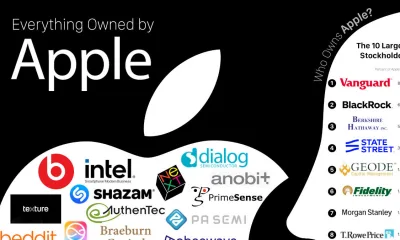
 Business Visualizations1 year ago
Business Visualizations1 year agoEverything Owned by Apple
-
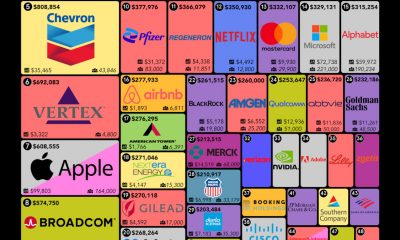
 Business Visualizations1 year ago
Business Visualizations1 year agoAmerica’s Most Valuable Companies Ranked by Profit per Employee
-
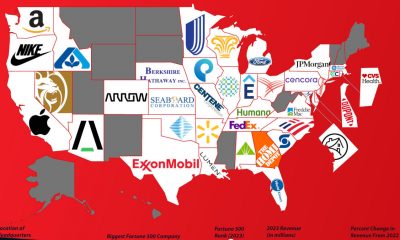
 Business Visualizations10 months ago
Business Visualizations10 months agoThe Biggest Fortune 500 Company in Every State
-
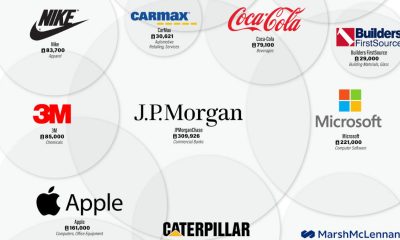
 Business Visualizations7 months ago
Business Visualizations7 months agoThe Biggest Employers by Industry
-

 Maps2 years ago
Maps2 years agoPenis Lengths Around the World
-
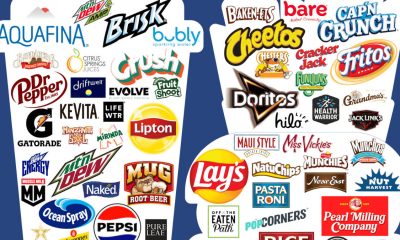
 Business Visualizations2 years ago
Business Visualizations2 years agoAll The Brands Owned By PepsiCo
-
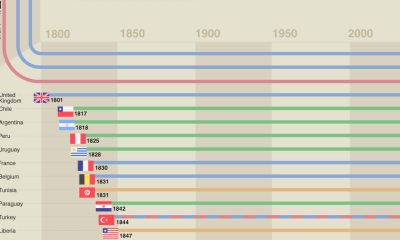
 Timelines2 years ago
Timelines2 years agoA History of the Oldest Flags in the World
-
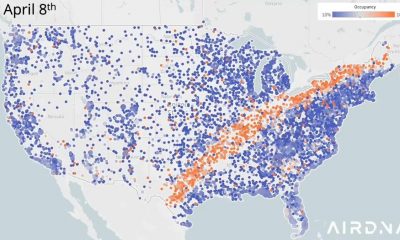
 Business Visualizations2 years ago
Business Visualizations2 years agoNew Animated Map Shows Airbnb’s Fully Booked Cities Along the 2024 Eclipse Path of Totality




